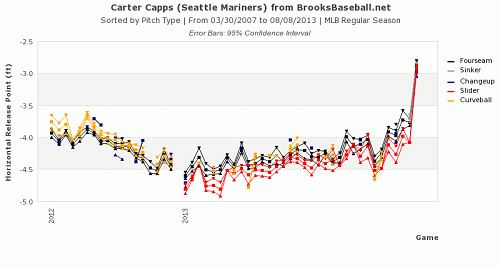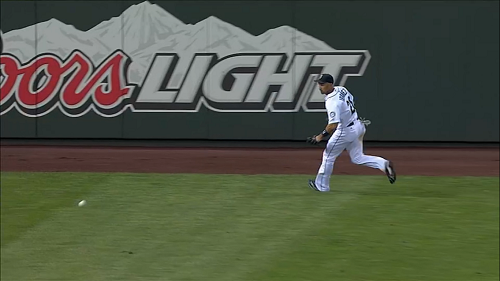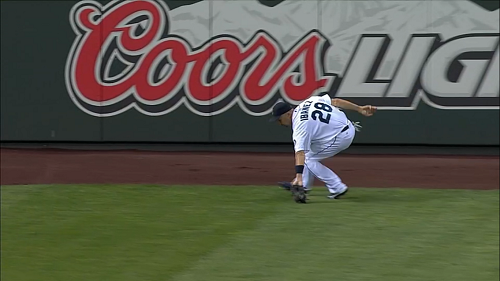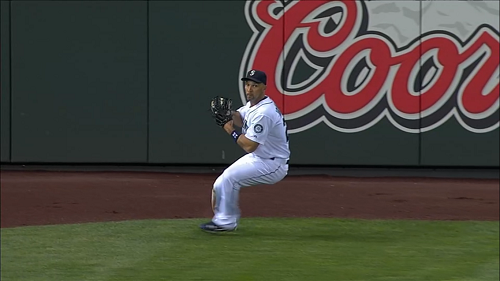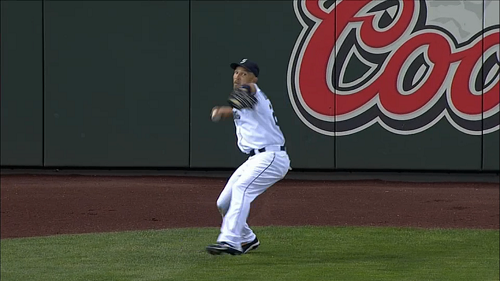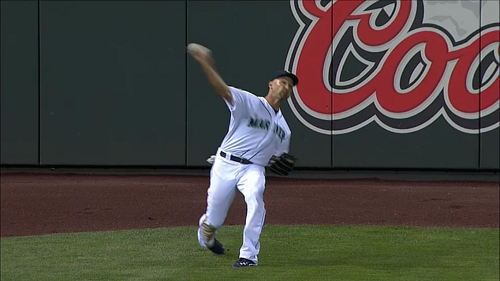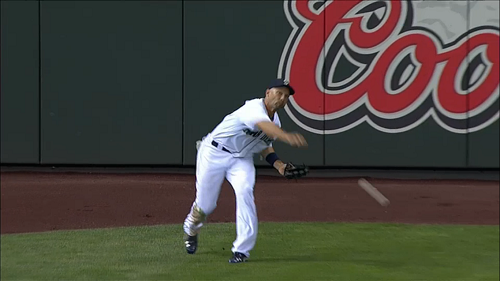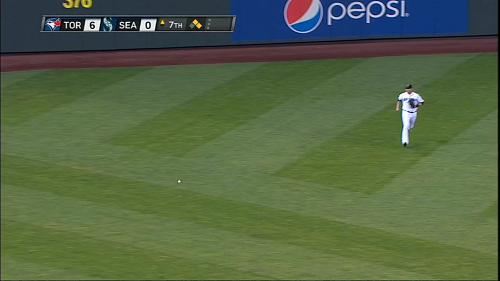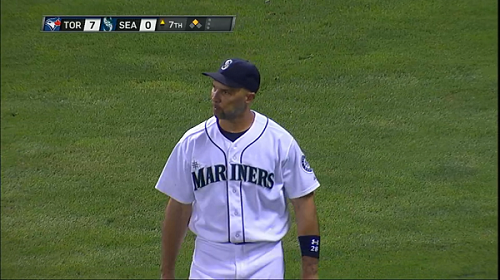Just For The Sake Of Reference
These days, both Alex Rodriguez and Ken Griffey Jr. are in the news, like the legendary athletic icons they are. Rodriguez is in the news due to further evidence that he’s missing…something, something critical, something the rest of us have that makes us all human. Alex Rodriguez, basically, is Bart after selling Milhouse his soul, except A-Rod lost his soul a few decades ago, and these days he’s more like a human-ish entity occupying the uncanny valley, leaving the rest of us unsettled. Griffey’s in the news for more positive reasons — he’s being formally inducted into the Mariners’ Hall of Fame, which sounds like a comical institution but which is not, at least not anymore, not now that it’s going to have Ken Griffey Jr. in it. Griffey grants any institution immediate legitimacy.
It’s an interesting contrast — Griffey, in some small way, is cementing his baseball immortality, while Rodriguez fights against professional excommunication. The Mariners want to make sure no one ever forgets about Ken Griffey Jr. If Bud Selig had his druthers, he’d make sure no one ever remembers Alex Rodriguez. Griffey promoted the game while Rodriguez tried to hurt it, and while Griffey had his own dark side, his issues were more that he was kind of an asshole sometimes. On occasion, Griffey could be standoffish. On occasion, Alex Rodriguez has told the truth, maybe. The darkness beneath Rodriguez flows deeper, flows faster, and while I used to think Rodriguez didn’t get enough credit for his Mariner accomplishments, it’s become easier and easier to understand why people don’t go out of their way to remember the good times. There was always something off about A-Rod, and now we’re finding out that something is A-Rod himself, the whole of who or what he is.
That’s all the commentary part, and people are perfectly justified to cheer Griffey on while booing Rodriguez away. There’s a reason Griffey and Rodriguez drew such disparate responses upon their initial returns to Seattle. Beyond the commentary, though, I’m just here to quickly highlight one thing. I don’t know why I was looking this up, but I looked it up anyway and now I’m going to share it. We can’t erase what Griffey and Rodriguez did on the field, nor should we want to. Regardless of how we feel about the players, the players generated their statistics, and for a time they did so in Mariners uniforms. Maybe there was some chemical influence, but there was chemical influence everywhere back then, so it’s probably safest to just assume everything more or less balanced out. Look at the Mariners in 1996.
That team finished second in its division, and Randy Johnson missed a lot of time with injuries. Those Mariners were famously loaded with talent, and they played 161 games. Had they played 162, they might’ve reached a total of 1,000 runs scored. Edgar was the DH, with a four-digit OPS. Jay Buhner was the right fielder, with a .926 OPS. But the standouts, of course, were Rodriguez at short and Griffey in center, the two combining to miss a few dozen games but the two also combining for an unthinkable level of performance.
According to Baseball-Reference, here are all the teams in baseball history to have two position players reach or exceed 9 WAR:
- 1996 Mariners
- 1930 Yankees
- 1928 Yankees
- 1927 Yankees
- 1906 Naps
The players:
- Griffey/Rodriguez
- Gehrig/Ruth
- Gehrig/Ruth
- Gehrig/Ruth
- Lajoie/Turner
Griffey was amazing in every single facet. Rodriguez, too, was amazing in every single facet, actually out-hitting Griffey while playing the toughest infield position. Griffey, that year, turned 27 years old. Rodriguez turned 21.
Juan Gonzalez won the 1996 American League MVP while posting a WAR under 4. That’s laughable, but that’s also not the point. Here’s the point I really wanted to get to: remember last year’s MVP debate about Mike Trout versus Miguel Cabrera? Remember how Trout had the WAR, and Cabrera had the Triple Crown and the playoff berth? Last year, Trout and Cabrera played for different teams. The 1996 Mariners basically had Trout and Cabrera. Everyone knows those Mariners were stacked, but I think it’s helpful to bring up more current examples to help shed light on what they really had. Last year, Trout was amazing. Last year, Cabrera was amazing. The Mariners essentially had both. They also managed to miss the playoffs.
It’s been a long time since Griffey’s peak. After the Mariners traded him, he had only one more season with a WAR over 3. It’s been less time since Rodriguez’s peak, but no one thinks about that A-Rod anymore, and certainly few people still think about his days with the Mariners. It’s incredible, however, how blessed those Mariners were. These days, it’s clear that one of those superstars isn’t quite human. Back in the 90s, neither of them were.
Game 115, Zombie-Mariners at Mariners
Joe Saunders vs. Kyle Lohse, 7:10pm
Ah, the Brewers. For a team that’s been in the National League since 1998, and (thanks to the M’s incompetence) never really figured in playoff races during the time both teams played in the AL West, the Brewers are easy to mock. It all starts with the Pilots, of course, and Bud Selig’s acquisition of the bankrupt Seattle team, which he quickly moved to Milwaukee.* Then, the late 80s and early 90s saw a series of violent (for baseball) brawls between these two teams, including a day game that is forever imprinted on my memory. On May 28th, 1989, the Mariners were in Milwaukee, and they took a 4-0 lead into the bottom of the 3rd behind Bill Swift. The Brewers got a run back behind an error and two singles, and had the bases loaded with no one out. Swift got Gary Sheffield to pop out, then induced a comebacker from Rob Deer. Swift threw home to get Billy Speiers, and Dave Valle had enough time to pivot and get Deer at 1st. After the throw, however, Speiers took out Valle’s legs, injuring the catcher’s knee. Valle couldn’t walk on it, so the M’s trainers worked on Valle as he lie in the dirt of the batter’s box. After 10 minutes or so, Milwaukee pitcher Chris Bosio decided he was tired of waiting and, with his catcher crouching about three feat from Valle, started his warm up tosses. Valle was displeased, miffed even.
The resulting brawl was significant, though it may have been upstaged by the brawl the two clubs had a bit over a year later. Still, the image I’ll never forget as the crowd panned over the chaotic scene was an extremely tall man with an unidentified Brewer clasped in a headlock. Welcome to the Mariners, Randy Johnson. RJ had been acquired in the big Mark Langston deal three days earlier, on the 25th, and wouldn’t make his first appearance for the M’s, er, in a playing capacity, until the 30th. In the days before cable contracts, only a few games were on TV. In my mind, this was RJ’s introduction to Seattle – a tall, gangly man running in from the bullpen to put a chokehold on Terry Francona. It’s possible that the M’s had another game televised between on the 26th and 27th; I have no idea. I just knew I was having some trouble believing that Langston was gone, and the M’s acquired three guys I’d never heard of. For whatever reason, that scene helped me get over not only the trade but Langston’s less-than-pretty exit. Both Langston and the M’s seemed annoyed they couldn’t agree on a deal to stay, so Langston made some disparaging comments about the team on his way out. The M’s were weighing on offer from the Mets that would’ve brought in Sid Fernandez and Rick Aguilera, and I think many in Seattle saw the Expos’ prospect haul as a much worse return. I don’t think Johnson brawling for Valle’s honor and knee tendons changed that equation, but I decided to stop worrying and learn to love the freak in the #51 shirt.
Ok, enough of that. These are the present day Brewers, the team that fancied itself a contender in the NL Central this spring, and whose dreadful 2013 includes compiling the 2nd worst record in the NL behind the not-really-trying Marlins, the suspension of Ryan Braun (just a reminder, his big contract extension kicks in for the *2016* season), and injuries to Aramis Ramirez and Corey Hart.** Like the M’s, the Brewers aren’t, in 2013, a high payroll club. But look where their money’s going. The highest paid Brewer in 2013 is today’s starter, Kyle Lohse. the 2nd through 6th spots go to Rickie Weeks (victim of an Ackley-like collapse; -0.2 fWAR), Hart (out for the year with a knee injury, free agent in 2014), Aramis Ramirez (injured, power mysteriously missing, 0.4 fWAR), Braun (suspended, had 9 HRs on the year), Yovani Gallardo (frustrating, bad RA, Brewers apparently tried to move him at the deadline), and John Axford (team’s star closer in 2011, then collapsed in 2012 and hasn’t yet recovered; -0.4 fWAR). There’s a lot of luck in there, and there’s the big suspension caveat of course, but the Brewers’ highest paid guys are giving them less than stellar production. It’s reminiscent of the M’s teams of the Bavasi years, with Carlos Silva, Miguel Batista and, to be fair, Ichiro, earning the big bucks while King Felix was paid like a journeyman 4th OF.
Lohse has actually been pretty good this year, with a so-so fWAR offset by a solid ERA. He’s still the same guy he was most of the time in St. Louis: a sinker/slider/change/curve guy with absolutely no eye-popping stuff who just seems to generate outs. Many people assumed that pitching to Yadier Molina (he of the pitch framing Molina brothers, and incredible defense overall) and working with Dave Duncan combined to make his fWAR and W/L records much better than his true talent, and thus bidding for Lohse’s services this year was surprisingly muted. The Brewers walked away with him for a three-year, $33m contract. Lohse still relies on a located 89mph sinker, a change and curve to lefties and a slider to righties. He’s not afraid to the throw his slider to lefties as well, however; he throws it about as much as his change-up to them. While this strategy was pretty successful in St Louis, it hasn’t worked as well this year. His change has been effective, however, and thus his splits are essentially even overall. As a result, this isn’t a great match-up overall for the M’s, but it’s still good to face a righty. It’s also nice that the Brewers have been one of the worst teams in the league against lefties overall, thanks to the worst HR/9 against them.
1: Miller, SS
2: Franklin, 2B
3: Seager, 3B
4: Morales, DH
5: Morse, RF
6: Ibanez, LF
7: Smoak, 1B
8: Saunders, CF
9: Quintero, C
SP: J. Saunders
The big name prospect starting in the M’s minors today is Edwin Diaz for Pulaski. Jordan Shipers has had a miserable, injury-riddled season for High Desert, but he’s talented and could help his stock with a good final month. He’s starting for High Desert. Hector Noesi has had a miserable season for multiple teams, but he too is talented, and…honestly, I’m not sure what to make of his stock at this point, but he’s starting for Tacoma in wild, wondrous Albuquerque. Lefty Anthony Fernandez gets the ball for AA Jackson.
The Rangers completed their slow-motion acquisition of ex-White Sox OF Alex Rios today, supposedly for IF Leury Garcia.
* Wikipedia tells me Selig had tried to keep the Braves in Milwaukee, and then worked tirelessly to “prove” Milwaukee could support a team, including hosting White Sox games at County Stadium in the 60s. This whole “so hurt by his hometown franchise moving, he devoted himself to moving someone else’s franchise” dynamic has at least some similarities with the Sonics saga of the past five years, a comparison that sounds much more damning than I mean it to.
** Somewhere on the East side, Dave Valle has a spring in his step as a feeling of contentment washes over him. He flashes that wide smile as he realizes his knee hasn’t felt so good in years.
Just Some Carter Capps Stuff, Whatever, Forget About It
WHAT
Courtesy of Brooks Baseball, here’s a graph of Carter Capps’ horizontal release points over time. Negative numbers on the y axis refer to distance from the middle of the rubber toward third base, in feet. The graph is complicated, but it’s not, really.
Updated Thoughts on Justin Smoak
It’s an off day, so let’s talk about Justin Smoak again. Last summer, I gave up on Justin Smoak as a core building block for the future, noting that his performance put him in the company of a bunch of guys who represented a pretty mediocre upside. Then Smoak came back from Tacoma and had a monster September, earning him One Last Chance (TM), but his slow April start resulted in yet another post pointing out his lack of power for a first baseman, and why it was going to be hard for him to produce without that skill. Even a month ago, when Jeff wrote about Smoak’s latest hot streak, I remained skeptical.
But he hasn’t really cooled off since that post, and now, Justin Smoak’s productive sample size is more than a hot month here and a hot month there. You’ve always been able to selectively pick dates based on his hot streaks that made him look decent, but it was never intellectually honest. It was always based on creating constraints specifically designed to exclude his bad performances while including all of his good ones. You can make anyone look good by doing that, and it’s a lousy way to project future performance.
At this point, though, we can look back at non-arbitrary cutoffs, like “past 365 days”, that do not require us to bias things in Smoak’s favor. And over those last 365 days, Smoak has 503 plate appearances and a 132 wRC+, putting himself just ahead of Prince Fielder. During that stretch, his .172 ISO is a match for Adrian Gonzalez. His 12.7% BB% puts him right there with Paul Goldschmidt, the Diamondbacks 2013 MVP candidate. His strikeout rate is basically league average. This is what Justin Smoak was supposed to be. He’s only hit 17 home runs, but everything else has been good enough that the overall production level has made him an above average player.
If Smoak’s last 365 day line was Smoak’s projection, then the Mariners should have no problem penciling him in as their first baseman for the next several years, at least while he’s under team control through arbitration. It’s not star performance, but good teams have useful average players instead of gaping holes, and it’s especially helpful when those average players make hardly any money.
So, yeah, thumbs up for the current version of Justin Smoak. He finally looks like what we thought he’d turn into, and is justifying the Mariners continued faith in his abilities. Their patience has paid off, and now Smoak looks like he might have played himself back into the discussion of the team’s young core, especially since there aren’t any other first baseman in the organization pushing for playing time.
That said, I’m still a bit of a Smoak pessimist going forward. It is always tempting to look at a player’s recent performance and judge him only on that and not everything that came before it, but it is almost never better to make a projection of future performance by throwing out older data. You should not weigh it as heavily as recent performance, but it’s still useful data, and forecasts based on a larger sample almost always trounce forecasts based on recent performance only. There are exceptions to the rule — Danny Farquhar is probably a good one right now, given that he’s throwing 96 over-the-top rather than 91 side-arm — but those exceptions are best identified by some kind of drastic physical change rather than just a performance fluctuation.
Smoak’s made some changes to his swing, but these are tweaks, not a total overhaul. He’s still basically the same guy who had 1,250 lousy plate appearances before his monster September last year. We now have 1,250 PAs of bad performance and 500 PAs of good performance. The fact that those 500 PAs are the most recent matters, as does the fact that Smoak is 26 and headed into what should be his peak years. But we can’t just ignore the older data now that we have more recent data that we like more.
If we look at the projections for Smoak’s future performance based on the entirety of his data — with recent data weighted more heavily — we see that ZIPS is projecting Smoak to post a 106 wRC+ for the rest of the year, while Steamer comes in at 104. In both cases, ZIPS and Steamer look at Smoak’s walk rates, strikeout rates, and isolated slugging and think that his current performance is almost exactly what he’s going to keep doing going forward. These core skills are not expected to regress much if at all.
Instead, the entirety of the drop in performance comes from a big projected drop in Smoak’s BABIP. His 2013 BABIP is .335, while ZIPS is projecting .291 and Steamer is at .273. I think Steamer’s probably too low, and would side more towards ZIPS projection, but even with a .291 BABIP, a lot of Smoak’s offensive value goes away. Over the past year, here are the first baseman that posted a wRC+ close to the 106 that ZIPS is projecting: Adam Dunn (109), James Loney (108), Chris Carter (107), Mark Reynolds (107), Eric Hosmer (105), Adam LaRoche (105), Ryan Howard (102). That isn’t exactly great company, and of that group, Loney is the only one who has been an above average player, as his defense is legitimately excellent.
ZIPS and Steamer aren’t infallible. That they both are somewhat pessimistic about Smoak’s rest-of-season production doesn’t mean that he can’t keep proving them wrong. Players improve at different rates, and Smoak may very well be an outlier who took a big leap forward, where it will take the projections a while to catch up. But I’d be more sold on this idea if there was a clear and obvious core skill where Smoak had shown a drastic change.
On one hand, you can argue that he’s just hitting the ball harder, except his HR/FB ratio is 12%, exactly in line with his career numbers, and his .165 ISO is just barely above his career .156 mark. His contact rate is 79.5%, almost exactly what it was last year, and his contact rate on pitches in the strike zone — generally the ones that get whacked the hardest — is right in line with his career averages. He’s swinging at the same rate he always has, and at the same proportion of pitches in and out of the strike zone.
The results are better, but it’s not immediately obvious as to why. The “he’s hitting the ball harder” argument is a bit circular, as the evidence for the harder hit balls is that his BABIP is higher, which is the thing we’re trying to explain to begin with. You can go round and round in that circle all day without actually proving anything. His line drive rate is up, but line drive rate is highly variable from year to year, and it might just be that his balls are being labeled as line drives because they’re going for hits rather than outs. It’s not clear where the causation lies, basically.
So right now, Justin Smoak is better, but he’s better almost entirely due to the one variable that fluctuates the most. And that’s a little scary. It’s the same reason James Loney is having a career year in Tampa Bay, and I’d imagine we’re probably all a little skeptical of Loney as a high quality first baseman going forward. The Rays got Loney for $2 million as a free agent, by the way. Underpowered first baseman who are average or slightly above average when their BABIP spikes aren’t all that highly valued in the market.
I’m glad to see Smoak hitting, and I hope he keeps hitting. He’s hit well enough for long enough that he’s earned a job in 2014, barring some kind of huge late season collapse anyway. But I still think the Mariners should be looking for an alternate first baseman of the future. Smoak has moved himself out of the high priority replacement list, and the Mariners should keep riding his success as long as it lasts, but at the same time, they should at least prepare for the fact that this might not last much longer.
Justin Smoak has earned himself a longer leash. He’s played himself back into the team’s plans, and should be penciled in as the starting first baseman on the 2014 team. But we should not yet be convinced that he’s going to keep this up. It’s great that he’s done it for 500 plate appearances, but bad players have 500 PA stretches of good performance. I’m not saying Smoak is definitely still a bad player, but we don’t yet know that he’s a good one.
Be encouraged. The fact that he’s hitting is good news. But be cautiously encouraged, and don’t be too shocked if this doesn’t last. Smoak would hardly be the first player to ride a BABIP wave to an unsustainable performance, only to have it end out of nowhere. If you need an example, Michael Morse is right over there.
Game 114, Blue Jays at Mariners
Aaron Harang vs. JA Happ, 12:40pm
JA Happ was activated off of the 60 day DL to make this start; you may remember the scary incident in Toronto when he was struck in the face by a Desmond Jennings line drive in May. That injury fractured his skull, and then to add injury to injury, he sprained his knee falling to the ground. The lefty made a few rehab starts for AAA Buffalo, and while he wasn’t terribly effective, he showed his stamina was mostly back (he threw 95 pitches in his last start).
Happ has one of the most distinctive fastballs in the big leagues. In 2011, he had the most vertical movement of anyone who pitched at least 100 innings. In 2012, he was #2, just a bit behind Clayton Kershaw. Unlike Kershaw or Josh Collmenter (#2 in 2011), Happ gets a more-or-less-normal amount of horizontal movement. This differentiates him a bit from the pure over-the-top guys, though to be fair, it doesn’t make the pitch particularly good either. He generates a few more whiffs than a 90-91mph fastball should, but the vertical movement means he gives up quite a few fly balls, and thus some home runs.
While a ton of vertical movement can occasionally negate platoon splits, Happ’s splits are pretty traditional. While his fastball’s generated exactly the same whiff percentage (8.92%) to both lefties and righties, righties get a few more HRs, and that’s enough to push his career FIP vs. righties a full run higher than his career FIP to lefties. So far this year (remember, that’s a tiny sample for him), he’s thrown quite a bit more sinkers (which have more v-mov than most anyone’s four-seamers, but do sink a bit compared to Happ’s four-seam), and a cutter to lefties and a change-up to righties. He’s also got a curve ball that he uses infrequently, in part because he struggles to keep it in the zone. The change-up/cutter actually generate some grounders, but he’s given up HRs and extra-base hits on them as well. In short, Happ’s a pretty good example for why DIPS and peripheral analysis exists. By FIP, he’s pretty much the same guy, year after year. FIP in the mid-4’s, decent number of Ks, few too many walks, average-ish HRs. BABIP swings (and the occasional HR spike) can make him look like a great #3 or a hanging-on-to-#5 starter by ERA.
To be fair, Aaron Harang’s another good example of this, as his BABIP and especially his HR/FB cause large swings in his ERA, while his FIP moves in a much narrower band.* But because HRs are such a driver of FIP, Harang’s career can really be broken into two halves – the first half (through 2007), when his FIP was always under 4, and the second half (2008-13) when his FIP’s generally been in the mid 4’s due to a persistent HR problem. Harang has probably pitched better than it seems like, and he may be a decent buy-very-very-low candidate for someone, but I’m pretty much done. The M’s looked to be swimming in pitching depth in March and then for a brief, shining moment in early July, but Paxton’s recent struggles and Hultzen’s second injury have eliminated much of it. The M’s will be looking for another Harang this off-season, whether it’s the actual Harang or someone else we’ll slowly grow to hate watching more than is strictly deserved.
1: Miller, SS
2: Franklin, 2B
3: Seager, 3B
4: Morales, DH
5: Morse, RF
6: Saunders, CF
7: Smoak, 1B
8: Ackley, LF
9: Quintero, C
SP: Harang
Victor Sanchez starts for Clinton today, with Trevor Miller getting the ball for Jackson.
* Yes, yes, that’s sort of the point of FIP. Not looking at BABIP/sequencing by definition produces a narrower range, and this helps reduce FIP’s error in predicting next year’s ERA. But still, some players see a lot more variance in their ERA than others – generally those hurlers who don’t rack up a ton of strikeouts and thus have more balls in play.
Pinpointing The Moment At Which It All Went Wrong For Raul Ibanez
Featuring screenshots, remarks, and things Tom Emanski might have said, if Emanski liked to speak in advisory rhymes. To be honest I never watched those videos beyond the minute-long TV commercial.
Remark
Raul properly approaches the ball, taking a good angle to make sure it wouldn’t get to the wall. At the moment of contact, there was a runner on first, and Ibanez would’ve wanted to prevent him from scoring. Failing that, maybe Ibanez could keep the hitter to a single.
Emanski
Run the right line, you’re doing just fine.
Remark
Raul backhands the ball, successfully cutting it off. He’s low to the ground and in good position to get his feet set and throw.
Emanski
Cut the ball off and the watchers won’t scoff.
Remark
Right away, Raul gets himself into good throwing position. He’s stopped his forward momentum, and he’s turned to face the infield, with his feet locked and his free hand retrieving the baseball.
Emanski
With smooth stopping and turning, your knees won’t be burning.
Remark
Raul looks like a pitcher, with his glove arm extended, his front foot in the air, and his back leg bent. He’s channeling momentum in a line toward an infielder, and he has his eyes on the target.
Emanski
To make a good throw, you need to have mo’.
Remark
Raul prepares to release, with his glove over his front knee and his back foot shifting forward. His eyes are still locked, and though his left foot is closed, pointing inward, we’ve seen pitchers like Ian Snell get by despite this. Still, it’s a troubling indicator in an otherwise picture-perfect screengrab.
Emanski
With feet closed at release, success will decrease.
Remark
Raul forgets to let go of the baseball at the right moment during his throwing motion, instead spiking it into the ground nearby. This is pretty much nothing short of a humiliating catastrophe, and it’s not the first time Raul has done this, and everybody is watching, and these are the moments in which you’re thankful Raul still gets to play the outfield despite all the evidence suggesting declaring such strategy is a mistake. Raul basically had it all down except for the last bit where you let the baseball go, i.e. throw it. This played out as if there were a throwing-motion sequel to QWOP.
Emanski
If you forget to let go, your throw’s gonna blow.
Remark
A different outfielder jogs to retrieve Raul’s throw attempt, which crash-landed shortly after takeoff. In this sequence, Raul treated the center fielder like a cut-off man, and then he missed him.
Emanski
A thrower to center’s a problem inventor.
Remark
Raul temporarily takes no pride in his defense.
Emanski
When your throw isn’t aces, be sure to make faces.
Game 113, Mariners at Blue Jays
King Felix vs. Josh Johnson, 7:10
This was supposed to be one of the most anticipated pitching match-ups of the year. Yes, the Jays had last year’s NL Cy Young winner, but Josh Johnson was perhaps the most talented new Blue Jay. He’s been beset by injuries, but he also put up a 6 WAR season in 2010, a year after a 5.5 WAR campaign. His fastball was down 1-2 MPH since returning from injury, but he’s still got plus velocity, as well as a curve, a change and a slider he throws to righties and lefties.
His big fastball didn’t have the natural sink of Yoervis Medina’s, but Johnson located it fairly well and in doing so maintained very low HR rates over the course of several seasons. His career high in any year was 14, a figure he hit three times throwing between ~160-210 innings. You can imagine Jays fans surprise then that Johnson’s yielded 15 already in just 76 innings pitched. Something’s gone terribly wrong with Johnson, and it’s not clear exactly what. Optimists will point out that his xFIP is actually better than it was in 2012, when he amassed 3.5 WAR. It’s essentially right at his career average. Sure, he’s not the dominant, untouchable force he was in 2010, but he’s a contributor whose been wrecked by terrible luck, much of it related to his inability to stay healthy. Pessimists will say that when a pitcher who’s famous for limiting home runs suddenly starts giving up lots of home runs, writing it off as “luck” and betting on regression may not work. As we’ve all discussed today, some times pitchers really do need to change something.
Johnson’s fastball movement and release point aren’t quite what they were before his 2011 shoulder injury, but it doesn’t look noticeably different than it did in 2012. He’s given up most of his HRs at home, like RA Dickey, but his overall results have been worse on the road, thanks in part to a comical BABIP and strand rate; HRs account for only a portion of his misfortune. He’s been destroyed by righties, which is so incongruous that it seems to benefit the “optimists” who’d point to luck and injury to explain why a Cy Young contender’s sporting an RA of 7.58. The BABIP stuff looks bizarre, and it’s definitely possible it’s inflated by a few games when he tried to pitch through injuries (he missed several weeks in May/June with a triceps injury). I just wonder why the Blue Jays have given up so many HRs, with guys like Dickey and Johnson seeing HR/FB increase and giving up more fly balls in general to boot. Is it related to Rogers Centre itself? Is it particularly homer-friendly with the roof closed (Safeco’s noticeably friendlier closed? Is it just a few pitchers having bad years? Whatever it is, this match-up reminds me of how rare and incredible it is for a pitcher to combine talent with durability. If you compared Felix to Johnson strictly on tools, I think Johnson might *might* come out ahead. Unless, of course, you view health as a tool.
1: Miller, SS
2: Franklin, 2B
3: Seager, 3B
4: Morales, DH
5: Ibanez, LF
6: Morse, RF
7: Smoak, 1B
8: Saunders, CF
9: Blanco, C
SP: King Felix
The big story in the minors was Wilhelmsen’s start, but James Paxton followed and pitched poorly as well. Not a great day in Tacoma, as the Rainiers lost 10-3. Charles Kaalekahi starts for Clinton while Anthony Vasquez pitches for Jackson.
Shannon Drayee recently tweeted that, according to Carl Willis, Wilhelmsen is NOT transitioning to the rotation, but is just getting slightly longer appearances (like today’s 2IP start) to work on his other pitches and his mechanics.
Farewell, Neat Closer; Hello, Neat Closer
For Tom Wilhelmsen, you could say these have been the nine weeks that changed everything. Today, Wilhelmsen started in Triple-A. He didn’t last long, and he pitched poorly, then effectively. The team’s all but admitted this is an experiment as they try to get Wilhelmsen to recover his confidence, and as they try to figure out of how much he might be capable. A little over nine weeks ago, Wilhelmsen was the Mariners’ closer, with a dozen saves and a sub-1 ERA. Sure, you could say maybe there were statistical indicators of trouble. But at the end of May, Wilhelmsen was the closer, and there wasn’t any question. Now the team doesn’t know what he is. He’s basically a prospect again.
And there’s a new closer, even if the team won’t admit as much. Just as Brandon League followed David Aardsma, and just as Wilhelmsen followed Brandon League, Danny Farquhar seems to be following Wilhelmsen. If the team had its druthers, Stephen Pryor would probably be the guy. Or I guess if the team had its druthers, Wilhelmsen wouldn’t so much as need a replacement. But part out of creativity and part out of desperation, the Mariners rightly overlooked Farquhar’s ERA, and now he’s got some saves. When the save train gets rolling, it can be hard to stop. Maybe it’s actually easy to stop, but saves lead to saves. Every save makes a closer more and more established, until he can’t save anymore.
Naturally, I like Farquhar. Any stathead probably likes Farquhar. Among relievers, he has baseball’s seventh-highest strikeout rate and third-lowest park-adjusted xFIP. That’s a grad school way of saying “his meaningful numbers are really good,” and more, Farquhar has a story. The Mariners identified him as a target because he’d added a cutter. They got him for Ichiro in what was thought to be a dump. At the time of the deal I barely even acknowledged Farquhar’s existence. Now he’s a potentially dominant reliever who could be helping the Mariners long after Ichiro’s retirement. It’s possible the Mariners managed to turn an aging, out-the-door Ichiro into an impact arm with a song and a nickname.
Of course, Wilhelmsen had a story. Still does. The story hasn’t changed. Wilhelmsen gave up baseball completely, for years. He removed himself from the competition. He returned, just to see, and he made it up to the bigs. He had a song and a nickname. It’s neat to think of where Danny Farquhar came from. It’s neat to think of where Tom Wilhelmsen came from. We enjoy telling the stories when the player’s successful. When they’re not, well, everyone has a story. What makes this guy so special?
The lessons with Wilhelmsen aren’t new. So far, 224 pitchers have thrown at least 40 innings in both 2012 and 2013. Wilhelmsen’s xFIP has climbed by 1.07 points. That’s the seventh-highest gain, between R.A. Dickey and Joe Nathan. Nathan’s gone from great to good. Wilhelmsen’s gone from good to project. A certainty then is a question mark now, and that much is hardly uncommon.
Last year, Wilhelmsen was 28, and he saved 29 games. Here are all the 28-year-old closers from the last five seasons to reach 20 saves:
- 2010 Brian Wilson
- 2011 John Axford
- 2009 Jonathan Papelbon
- 2011 Brandon League
- 2011 Carlos Marmol
- 2010 David Aardsma
- 2012 Tom Wilhelmsen
- 2009 Bobby Jenks
- 2012 Jonathan Broxton
- 2010 Francisco Rodriguez
- 2012 Huston Street
One of those guys remains a reliable closer. Rodriguez, granted, is a decent reliever. Axford, League, Marmol, Wilhelmsen, Street — they’ve had problems with ineffectiveness. Wilson, Aardsma, Jenks, Broxton — they’ve had problems with injury. Closers seldom last, because relievers seldom last. When you have trouble as a closer, someone else becomes the closer, and then it’s that much harder to get the job back. A true, long-term, proven closer has himself some job security, but you have to fight like hell to get there, and for a while you’re just a few slip-ups away from watching Danny Farquhar do your work.
It has to be nerve-wracking to be a closer. Not just because of the circumstances under which you make your appearances — because of the prominence of the role. Because of how easy it would be to not be the closer anymore, and because of what that would mean for a career. Some weeks ago, Tom Wilhelmsen would’ve told you he was a closer in the bigs. He can’t think of himself that way anymore, especially not with the Mariners starting him, and how would you respond, knowing your career could go in so many different directions? They say Wilhelmsen’s pitching without confidence. The stuff, obviously, is still there, unchanged. They want him to be able to find himself in Tacoma. I’m not excusing Wilhelmsen for his struggles, but I can see how this might snowball. You pitch with confidence until you mess up. When you mess up, you entertain the thought of messing up again. When you mess up too much, especially as a closer, everything changes, things are taken away from you. In some ways you have to be an idiot to play baseball. An idiot, or exceptionally naturally talented. Thinking’ll get ya.
Pitchers who relieve want to be closers, because closers get glory and closers get money. There’s an argument that closers shouldn’t exist in the first place, but as long as they do, pitchers are going to go for that, and they’re going to succeed until they fail. When they fail, if they fail often enough or early enough, some other pitchers will step in. It’s intensely competitive and it all has to be intensely anxious. Baseball is Tom Wilhelmsen’s life, and right now he’s almost 30 and he doesn’t know what his baseball job is. He’s pitching in Triple-A for the first time ever. He shares a clubhouse with Taijuan Walker and Josh Kinney. Kinney was as good as in the Mariners’ bullpen until he got hurt. He’s probably never felt further away.
It feels trite to say, but baseball careers change in an instant, and especially so for guys in the bullpen. Kinney was an injury from a major-league paycheck. Wilhelmsen was strikes from a proven label. Pryor was an injury from stepping in for Wilhelmsen. Farquhar’s in there now, thanks to some breaks, and because of those breaks, he could one day be a millionaire. He could one day be thought of as a part of the Mariners’ core, which, of course, because he’d be a reliever, he wouldn’t be. He wouldn’t deserve to be, but fans love closers, except for when they’re bad. Closers are the best, or closers are the worst.
The Mariners are going to find out what Wilhelmsen can do. They’ll find out what Farquhar can do, too, and they’ll go from there with new decisions. Ultimately, no matter what happens, they’ll survive. If Farquhar can’t close, they’ll try someone else. If Wilhelmsen can’t throw strikes, they’ll try someone else. For the Mariners, this isn’t all that important. For the pitchers, this is everything. You better believe major leaguers need to be over-confident. I can’t imagine what it would be like to be in the majors and think.
Tom Wilhelmsen, Maybe a Starter
Tom Wilhelmsen was optioned to Tacoma after last night’s game. Today, Tom Wilhelmsen is starting for the Tacoma Rainiers. These two things are related.
Wilhelmsen has obviously struggled this year, primarily with his command, but there are enough bullpen innings to go around that he could work on things in Seattle if they wanted him to. They’ve already done that earlier in the season, in fact. However, by optioning him to Tacoma, they’ve opened up a new path, and that potential opportunity begins today.
Per Greg Johns on Twitter:
#Mariners will let Wilhelmsen throw a few innings today. Not saying they're making him a starter yet, but want to see him in that situation.
— Greg Johns (@GregJohnsMLB) August 6, 2013
They’re not committing to Wilhelmsen as a starting pitcher. He’s only going to throw two innings today, and then they’ll re-evaluate from there. If he does well, he’ll probably get another start, and maybe go three innings in that one. If he bombs out, maybe this ends up being nothing.
But there are reasons to think that maybe this might work. Tom Wilhelmsen’s secondary stuff consists of a curveball and a change-up, both pitches that historically do pretty well against opposite handed hitters. He’s shown a bit of a platoon split in relief, but nothing too extreme. He’s not Carter Capps. His stuff works against left-handed batters, at least when he’s throwing strikes.
As a starter, working multiple innings, Wilhelmsen will almost certainly lose velocity. He won’t be able to throw in the high-90s for extended periods, so his fastball will probably settle in more around 93-96. There is some evidence that it is easier to throw 93 in the zone than 98 in the zone. It is possible that a reduction in velocity could actually help Wilhelmsen throw more strikes, which is his primary problem at the moment. While the strikeouts will go down, the walks very well may go down too, and it’s entirely possible that Wilhelmsen will be more effective as a mid-90s starter than a high-90s reliever.
It’s an experiment worth trying, I think. The raw stuff is there for Wilhelmsen to be a solid starting pitcher. His health was a concern after they signed him following his long layoff, but he hasn’t really battled any issues the last few years, and stretching him out now will give them a chance to see if he can maintain his velocity while throwing more pitches. If he can, and if the reduction in velocity helps him throw more strikes, then he could potentially be a rotation option for 2014.
Of course, he could bomb out as a starter too, and this might not end up going anywhere. If it doesn’t work, the Mariners can try him in relief again. No harm, no foul. It’s worth a try, though, and I’m glad to see the organization looking to see if perhaps this move might help him get back on track.
Game 112, Blue Jays at Mariners
Hisashi Iwakuma vs. R.A. Dickey, 7:10pm
Undervalued top-flight starter against formerly undervalued top-flight starter in Game 1 of a three-game set versus Toronto. The M’s come into the game with a better record than the Jays and Angels, two teams that were expected to compete for the ALCS this year. Dickey’s return to earth following his Cy Young-winning 2012 has less to do with the Jays misfortune than other things (Josh Johnson pitching like crap, Jose Reyes’ injury, Melky Cabrera turning back into a pumpkin, etc.) but it’s a concern given the Jays owe him $24m for 2014-15.
Early in the year, Dickey’s velocity was down a bit from where it’d been in 2012 (easily his best year as a big leaguer). There were signs in June that he’d recovered that missing mile-per-hour, but he gave it away again in July. Dickey certainly seemed to be a better pitcher with the extra oomph on his knuckleball, but it’s still not clear exactly why. Keeping the ball in the strikezone was one possibility, but he threw fewer strikes in 2012 than he had in any other year. His o-swing and contact rates were unbelievable in 2012, but he hasn’t been able to recapture that form, and thus his 2013 looks a lot like his 2009-2011 average. As Dave’s mentioned, that’s not bad – the Jays aren’t paying for a Cy Young winner, they’re paying for a middle-of-the-rotation guy, and Dickey *can* return some value to them. But he’s going to have to figure out why he’s losing so many grounders. Since learning the knuckler, he’s been a slight GB pitcher, peaking in 2010 with a 55% GB rate. That slipped in his next two seasons with the Mets, but it’s fallen through the floor this year, as his GB% is down to 41%. The knuckleball’s getting a few less grounders, but his fastball’s been a serious problem this year too. It used to look great on a rate basis, as it could surprise hitters whose timing was geared to a 76mph floater. For whatever reason, no one’s fooled this year, and Toronto’s a terrible place for fly-ball pitchers.
Many speculated about how Rogers Center would affect Dickey, with several believing the controlled environment would be conducive to a knuckler. Unfortunately, he’s been awful at home, with home/road splits like a Colorado Rockies hurler in 2000. Of course, the M’s aren’t playing in Toronto tonight, but a fly-ball heavy righty (Dickey’s had standard platoon splits for a few years) seems like a decent match-up.
I realize I spend an inordinate amount of time in these posts talking about opponents, so let’s shift focus to the M’s. Without looking, what pitches are swung most often? That is, what pitches generate the highest swinging percentage from opposing batters? It’s not fastballs, and it’s clearly not curves (which have high rates of “taken” strikes after freezing hitters). The slider is pretty close to the top, as those of us who’ve seen Adrian Beltre can attest. But the answer seems to be change-ups/splits. In fact, only two active pitches have induced swings more than Iwakuma’s splitter: Alex Cobb’s splitter and Tommy Milone’s change-up. This is somewhat remarkable, given that Iwakuma generally doesn’t leave his splitter in the strikezone – that is, only ~1/3 of Iwakuma’s splits are called balls despite the fact that less than 1/3 are thrown in the strike zone. Iwakuma keeps the ball down extraordinarily well, whcih allows him to generate huge GB% on it, all while racking up swinging strikes too. It hasn’t been untouchable this year, as the A’s recently hit three HRs off of it, but it’s still one of baseball’s better pitches.
So why doesn’t he throw it more often? Unlike, say, Steve Delabar’s, it’s effective against righties and lefties, and he’s given up HRs by the dozen on his fastballs. Iwakuma pitches up in the zone with fastballs much more than you’d expect from a guy 1) with a dinger problem and 2) with great command of his other pitches. It can’t be that Iwakuma’s trying his best to keep the ball low and missing repeatedly. Instead, I think he *needs* the fastball up to effectively disguise the splitter. If he threw four-seamers at the knees, the different shape of the split would be visible to batters much earlier, and his swing rate on them would presumably drop. If the fastball’s thrown in the zone and even above the belt, it’s going to look indistinguishable from the split at the time the batter decides to/begins his swing. So yes, Iwakuma’s fastball(s) don’t have great results, but they’re not really supposed to. They’re the sacrificial anode that protects his real weapon.
1: Miller, SS
2: Seager, 3B
3: Morales, DH
4: Morse, RF
5: Ibanez, LF
6: Saunders, CF
7: Smoak, 1B
8: Ackley, 2B (!)
9: Quintero, C
SP: Iwakuma
Blake Beavan starts in Tacoma tonight as the Rainiers host Iowa. Hey, Hector Noesi turned in a brilliant outing the other day, so why can’t Beavan? Anthony Vasquez takes the hill for Jackson.
You’ve probably read more than you’d like to about the Biogenesis suspensions, but here’s a great piece from BP’s Colin Wyers about why MLB went after the Biogenesis 12 with such fervor and the need to take a step back from the edge here (“Constant hysteria is unsustainable”). We are constantly shocked – SHOCKED – to find that chemists have come up with a new, currently-untestable PED, despite the Tour de France sagas, despite Balco and despite Biogenesis. This isn’t going away.

